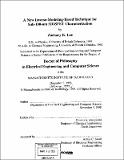A new inverse-modeling-based technique for sub-100-nm MOSFET characterization
Author(s)
Lee, Zachary Ka Fai, 1967-
DownloadFull printable version (10.67Mb)
Alternative title
New inverse-modeling-based technique for sub-100-nm metal oxide semiconductor field-effect transistor characterization
Advisor
Dimitri A. Antoniadis.
Terms of use
Metadata
Show full item recordAbstract
Performance and density of VLSI circuits have been rapidly improving over the years as transistors are miniaturized. As MOSFET transistor gates are scaled to the sub- I 00 nm regime, however, subtle details of the two-dimensional (2D) and three-dimensional (3D) redistribution of dopants, due to thermal diffusion during the fabrication process, strongly determine the short channel effects, which ultimately limit device operation and performance. In order to suppress short-channel effects, extensive use of non-uniform doping profiles are found in modem devices. Among these are the super-steep retrograde (SSR) channel profile, characterized by a low dopant concentration near the surface and a high dopant concentration at some depth from the surface, and the halo doping, characterized by a laterally non-uniform doping profile across the device channel. In order to engineer a device having good short-channel characteristics and performance, through dopant engineering, the 2D dopant distribution must be known accurately. A 2D doping profile characterization technique is therefore very important. Not only should it enable device engineering, but it can also be used as a tool for process monitoring and characterization. One dimensional ( l D) profiling techniques such as the C-V method and SIMS have been widely used. Direct 2D techniques, however, have met with less success. The first goal of this thesis is to offer a solution to this problem by developing an inverse modeling- based 20 doping profile characterization technique using subthreshold 1-V characteristics that (1) does not require special test structures, (2) is able to extract 20 doping profiles of devices with very short channel-lengths, (3) is immune to parasitic capacitances and noise, (4) has low sensitivity to gate area variations, (5) has low dependence on mobility, (6) is non-destructive, and (7) uses easily obtainable data. A second goal of the thesis is to demonstrate that knowledge of the 2D distribution of dopants can be used to calibrate transport (mobility) models, leading to highly accurate predictive capabilities useful for device design. An inverse-modeling-based transport model calibration methodology is then discussed. Lastly, parasitic effects such as source/ drain series resistance, that are important for device design, and may have an impact on the accuracy in simulating high-current 1-V characteristics, are discussed and analyzed.
Description
Thesis (Ph.D.)--Massachusetts Institute of Technology, Dept. of Electrical Engineering and Computer Science, 1999. Includes bibliographical references (p. 151-158).
Date issued
1999Department
Massachusetts Institute of Technology. Department of Electrical Engineering and Computer SciencePublisher
Massachusetts Institute of Technology
Keywords
Electrical Engineering and Computer Science